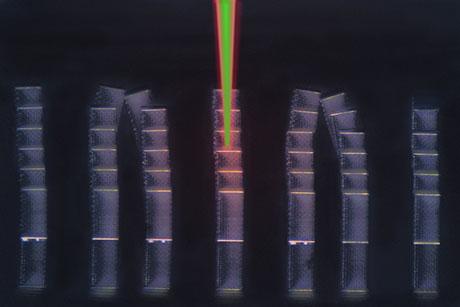Folkers Rojas (SB ‘09, SM ‘11, PhD ‘14)
The Case of the Welcome “Hairball”
by Alissa Mallinson

PhD student Folkers Rojas (SB ‘09, SM ‘11, PhD ‘14)
Photo credit: Tony Pulsone
What do a bathtub hairball and a MechE-developed blowout preventer tool have in common?
They both cause blockages.
In the case of a hairball, the blockage is caused by an unwelcome natural buildup of hair in the drain. The blowout preventer tool, on the other hand, is a system built by PhD student Folkers Rojas (SB ‘09, SM ‘11, PhD ‘14) to prevent oil from unintentionally spilling into the ocean, a purposefully engineered blockage. But the mechanics behind each of them are essentially the same.
It is the specific mechanics behind this idea that for the past few years has been at the forefront of the mind of Rojas, who is graduating this year – a challenge posed to him by his advisor Professor Alex Slocum.
“I wanted to pick a PhD focus that kept me up at night,” he says. “This problem had breadth; it had depth; it was a great engineering challenge. You’re looking at about 1.5 kilometers of water depth (which was the case for the Deepwater Horizon oil spill), but you’re also looking at approximately 3.5 kilometers for ultra-deep wells. And all of this is happening at a water temperature of 5° Celsius, and the temperature coming out of the well can be as high as 150° Celsius, so it is happening at extreme environmental conditions. The well diameter is about 0.5 meters, and you have to take into account the pressure as well, which is the equivalent of hanging 6 [Honda] Accords on each square inch of the 22 MIT Department of Mechanical Engineering wellbore cross-section. You also have to be able to remove the plug after you’ve closed the well.”
With all the government-imposed regulations and inspections on oil rigs these days, blowouts aren’t very likely to occur – and in fact often don’t – but sometimes there is a series of unfortunate events and no effective countermeasures in place, as happened with the Deepwater Horizon oil spill in 2010. According to Rojas, who recently won second place in this year’s DeFlorez Competition for his technology, it is an engineer’s duty to acknowledge and prepare for inevitable breaks and errors that can eventually lead to what could have been a preventable catastrophe.
“The technologies that are in place right now take anywhere from one to four weeks for the temporary solutions to arrive on site. For the permanent solutions, it can take between four to 10 weeks. Meanwhile, every second that the well is leaking, a bathtub’s worth of oil can be leaking into the ocean. It has a phenomenal negative effect on the environment but also on the oil company’s finances. The Deepwater Horizon oil spill cost BP more than $40 billion. So there is a need for a better solution.”
Rojas investigated several variables as he researched the solution that would be both efficient and effective considering all the concrete limitations, many of which are based on strict industry standards that exist to protect people, the environment, and company assets. The first aspect he looked at was the dynamics of the wire entanglements (i.e., the generation of the “hairball”). He had to find the right material and size so that the wire was neither too flimsy nor too stiff. Too flimsy and the wire will simply be swept away by the drag force of the flow; too stiff and the wire doesn’t entangle to create a blockage.

Courtesy of F. Rojas
The ideal solution ended up being a hybrid of the two, a stiff entanglement inside a free-flowing medium that gets anchored against the existing obstructions (that were designed to close the well but failed to fully close in the first place). The last stage is a sealing material that allows compression of the entanglement against the obstruction and is packed by the pressure inside the well to create a cohesive mechanical plug.
Rojas also looked at the mechanics behind generating just the right type of entanglement. He researched varying angles, tilts, rotations, and velocities until he found an effective one – it starts as a little ball that moves forward as it grows bigger and longer until it creates a plug that will anchor in the pipe despite the drag force. In other words, a continuous feeding mechanism that creates a mechanical plug. His last step was to prove that the solution was scalable and ready for the next development phase.
“This is a technology that we need,” says Rojas. “Someone invented airbags, and I am inventing the equivalent for oil production, an industry that isn’t going to be discontinued anytime soon. Until then, we need to do it more safely.”
Watch Folkers Rojas explain his research:


